The Kedarkantha trip, which should not be mistaken with the more well-known Kedarnath Temple, is located in the Govind Pashu Vihar National Park in the state of Uttarakhand. The trek lasts for a total of six days, including the days spent travelling from Dehradun to the base camp and back. Kedarkantha is without a doubt one of the most well-known hiking routes in India, and it is well-liked by both experienced hikers and those who have never gone hiking before. It is a relatively common journey that people do in the Indian Himalayas for a variety of different reasons. The ascent to the top of the mountain is by far the most crucial of them.

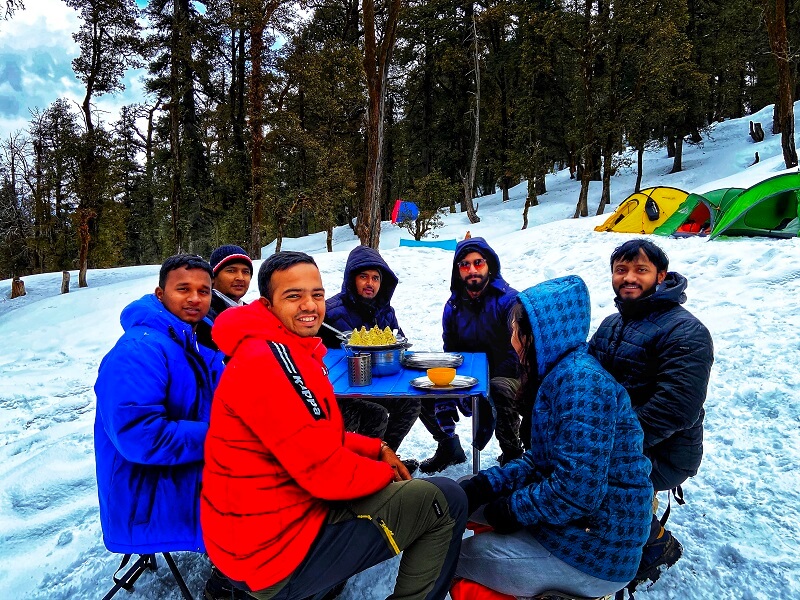
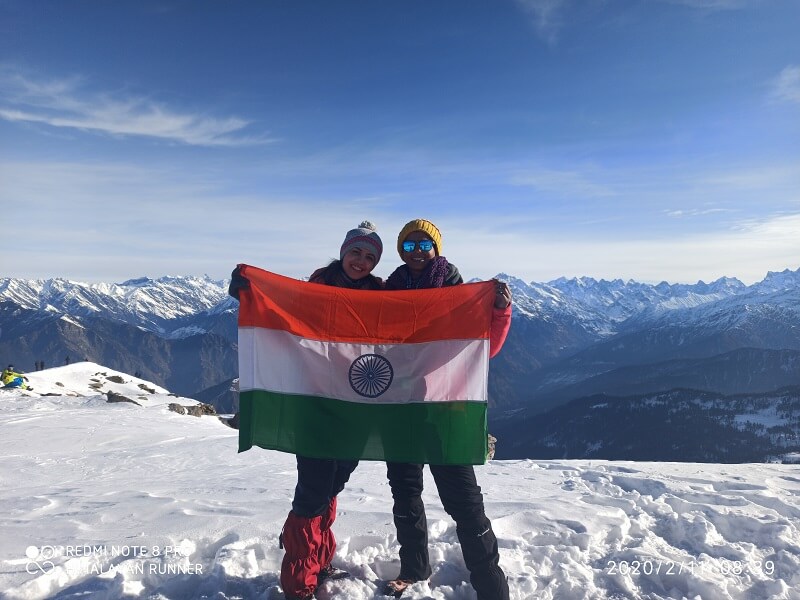
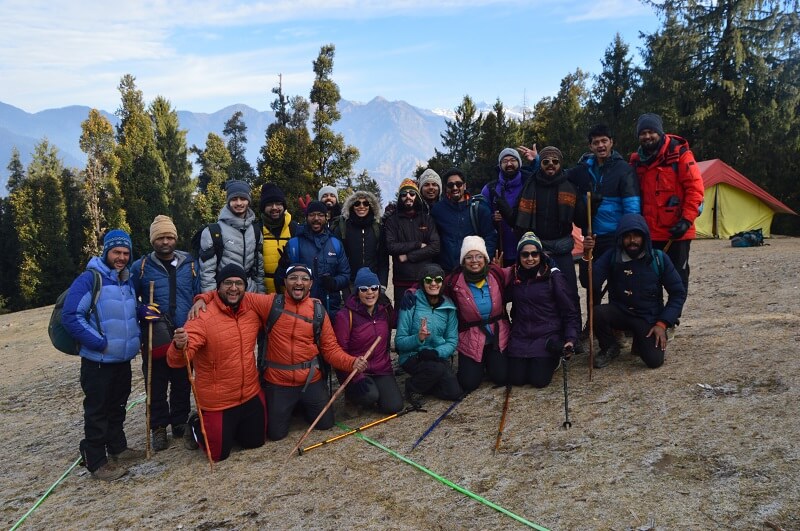

The ascent to the peak of Kedarkantha is one that is filled with many satisfying moments. The top is clearly seen even before leaving the starting point of the hike. As you begin your journey in the wee hours of the morning and make your way gradually up the steep slope of snow, you will notice that the landscape around you is beginning to open up. The ascent is not a simple task. The gradient remains constant throughout the whole distance. It becomes more difficult as you approach the peak of the mountain. However, the large mountains of the higher Himalayas keep you company until you reach the peak of the mountain for good.
You will experience a powerful feeling of fulfilment and success when you reach the peak of the mountain and stretch your body while taking in the breathtaking vistas of the Himalayas. This is a sensation that cannot be compared to any other. It is one of the few treks that offers the same level of excitement, which is one reason why its summit ascent is considered to be among the best. In addition to the peak, the hike is remarkable for the magnificent clearings that it passes through. On a hike, you could stumble onto a breathtaking clearing every once in a great while, which provides an opportunity for some rest stops and gorgeous campsites. Clearings may be found along all of the many paths that make up this hike. at addition, the clearings are at just the right places, providing you with stunning vantage spots from which to take in both the hike and the scenery along the way.
The presence of stunning trees is the third most important factor that sets this walk apart from others. Each of the three paths takes you through a stunning and varied forest that will completely immerse you. If you are not cautious, you will find yourself (emotionally satisfyingly) immersed in them.
Best Time to Visit Kedarkantha Trek
- There is likely to be some snow left over from the winter that has just ended in March; the amount of snow will be greater at higher elevations. In the shape of rhododendrons and newly exposed grasses, it will still have the beginnings of the spring season. Since April marks the beginning of the end for the winter season, any lingering snow will melt away then. A carpet of meadows, particularly at lower elevations, will provide a burst of colour everywhere you turn, especially in the springtime. The length of the days will increase, and they will be considerably brighter, while the evenings will become more pleasant. This time of year has weather that is ideal for hiking and exploring the natural world around you.
- In the month of May, Kedarkantha has mornings that are rather warm, followed by evenings and nights that are somewhat chillier, despite the fact that they are not as severe as those in other seasons. On the surface, the sun is shining brightly, and some individuals may even find that the temperature has reached a comfortable level. On the other hand, June is a month that does not mind a little rain now and then as long as it is light and not too consistent. The fact that most people choose to travel at higher elevations during the summer is one of the nicest things about going hiking at this time of year. This indicates that Kedarkantha is not very busy and provides many opportunities for solitude if this is what you want, provided that you are seeking for it. There is no snow to be seen at this time of year.
- In the months of June through August, when the monsoons are in full swing, hikers who are looking for a one-of-a-kind and verdant experience often give serious consideration to doing the Kedarkantha journey. It is crucial to keep in mind the difficulties that come along with monsoon treks, despite the fact that the verdant vistas and new growth of vegetation may be quite alluring. The pathways are prone to become slick, and continuous rain showers may impede vision, both of which make navigating challenging. Additionally, the likelihood of rivers being swelled and the presence of leeches are both factors that need to be considered. On the other hand, the Kedarkantha trek during the monsoon season may be a rewarding endeavour for those who are looking for seclusion and a fresh view of the Himalayas. To get the most out of this unconventional hiking adventure, it is important to be well-prepared with rain clothing, footwear that is appropriate for the terrain, and an acute knowledge of the weather forecast. It is crucial to approach this season with care and appropriate preparation, regardless of whether you are travelling solo or as part of a package for the Kedarkantha trip. Travellers often select this season for its one-of-a-kind atmosphere.
- Who doesn’t like the clean and refreshing air that winter offers, especially when it’s not accompanied by the biting cold? In any case, the weather in Kedarkantha throughout the autumns is rather comparable to that. The lovely wind that is building in the air gives the impression that the trees are practically alive, and the monsoon seasons are almost over, so the meadows seem to be in pristine condition. When you get to the summit, the view of the Himalayas is crystal clear. Despite this, these months are the beginning of the colder weather, particularly November. The temperature in Kedarkantha may drop below 0 degrees Fahrenheit during the night. At this point, there is still quite a bit of green in the mountains, so if you are someone who likes to appreciate the foliage while still experiencing a touch of cold, this is the ideal weather for you to visit Kedarkantha at this time of year.
- During the month of December, when the terrain is blanketed with snow, transforming it into a magnificent winter wonderland, trekking to Kedarkantha may be an amazing and rewarding experience. In spite of this, it is essential to be informed that hiking in the Himalayas in December presents a number of difficulties and dangers on account of the severe winter conditions that prevail there.
- In Kedarkantha, the beginning of winter is signalled by the arrival of fresh snowfall as well as colder temperatures. The snow continues to fall from the end of December all the way until the middle of February. In these conditions, the nights are bone-chillingly frigid, while the days give very little to no relief from the chill. However, if you dress appropriately and wear layers, you may turn a winter walk into the most delightful walk of them all. The nicest thing is that there are less people during this time of year (middle of January through February), making for a peaceful and enjoyable walk. Be prepared for the possibility that the path may be closed for two to three days due to snowfall during the height of the winter season. But when compared to the breathtaking scenery provided by the snow, all of it is but a minor convenience.
Trek Difficulty of Kedarkantha Trek
- The Kedarkantha trip ranges from simple to moderate in terms of its level of difficulty. This winter hike is suitable for hikers of all skill levels, from novices to seasoned veterans. The walk includes many ascents and covers an elevation gain of around 6000 feet along its course. This walk does not take place on a dangerous or potentially lethal path. There is just one obstacle on the route, and that is the snowfall, which may make walking a little difficult at times. The technically adept trek guides of Cliffhangers India, on the other hand, will ensure that you navigate the terrain in a very safe manner.
- The walk simply requires a minimum degree of physical fitness. Even though this walk is designed for novices, the path is made more challenging by the snow that has fallen and the snow that has accumulated. As one must climb during the winter months, the difficulty of the walk is significantly increased. Walking in snow makes each step more difficult. However, even someone who has never been hiking before may do this hike without any difficulty and in complete comfort.
- In addition, ensure that you have all of the necessary trekking equipment and supplies in order to complete this hike in a safe and comfortable manner. From the base camp in Sankri, you will be able to purchase practically all of the trekking supplies and anything else that a hiker may need while on the trail, so there is no need to worry if you forgot to bring the necessities with you from your home. Spend the evening before the first day of the walk wandering the alleys of Sankri in search of your belongings at prices that are within your budget.
- To briefly summarise how challenging the walk was. It would be accurate to claim that the journey is one that can be completed by everyone. The leader of the hike will educate you on the rules that you are required to follow for the hike, and then you will be ready to begin the hike.
Trek Itinerary of Kedarkantha Trek
Day 1: Drive from Dehradun to Sankri
The beautiful village of Sankri serves as the departure point for the Kedarkantha Trek. The road trip from Dehradun to Sankri is about 200 km long and travels through mountainous terrain on twisting roads. If you reserve your transportation with us, our cars will pick you up at the Dehradun I.S.B.T. terminal at 7 in the morning. You should plan to get at Sankri about sunset time. During this incredible road trip, we will go via Mussoorie as well as many other charming towns, where we will be treated to a spectacular view of the lush vegetation and rolling hills. We are going to take a trip that follows the banks of the River Tonnes, which will ultimately morph into the River Supin farther downstream. By the time it becomes dark, we’ll arrive in the Sankri. As a result of the several treks that are located in the surrounding region, Sankri has developed into a busy centre for hikers over the course of the last few years. There is a breathtaking panorama of the setting sun across the valley from where you will be staying, which is either a hotel or a guest home. Dinner will be given, and your trek guide will give you a comprehensive briefing on all of the aspects of the hike that you will be experiencing.

Day 2: Trek from Sankri to Juda ka Taal
After a nutritious breakfast, we will get an early start on our trek in the morning. The Kedarkantha route will lead you into a calm and peaceful grove of towering pines as soon as we start walking on the track. As you make your way up into the mountains and take in the breathtaking scenery, the enchantment of this path will begin to become more apparent. Depending on the time of year, you may encounter snow while you go along this path. During the depths of winter, the route will be covered with snow from the moment you set foot on it. Following a few of hours of foot travel, we will arrive at a Dhaba. We’ll take a break and have some snacks here. As you make your way up, the lovely oak trees at the Juda-Ka-Talab campground will greet you and invite you to stay there. There were once two smaller lakes, but they eventually came together to create one bigger lake known as Juda-ka-Talab. This location will serve as the overnight camping spot. When we get there, we’ll take some time to rest and unwind with a steaming cup of tea before continuing on.
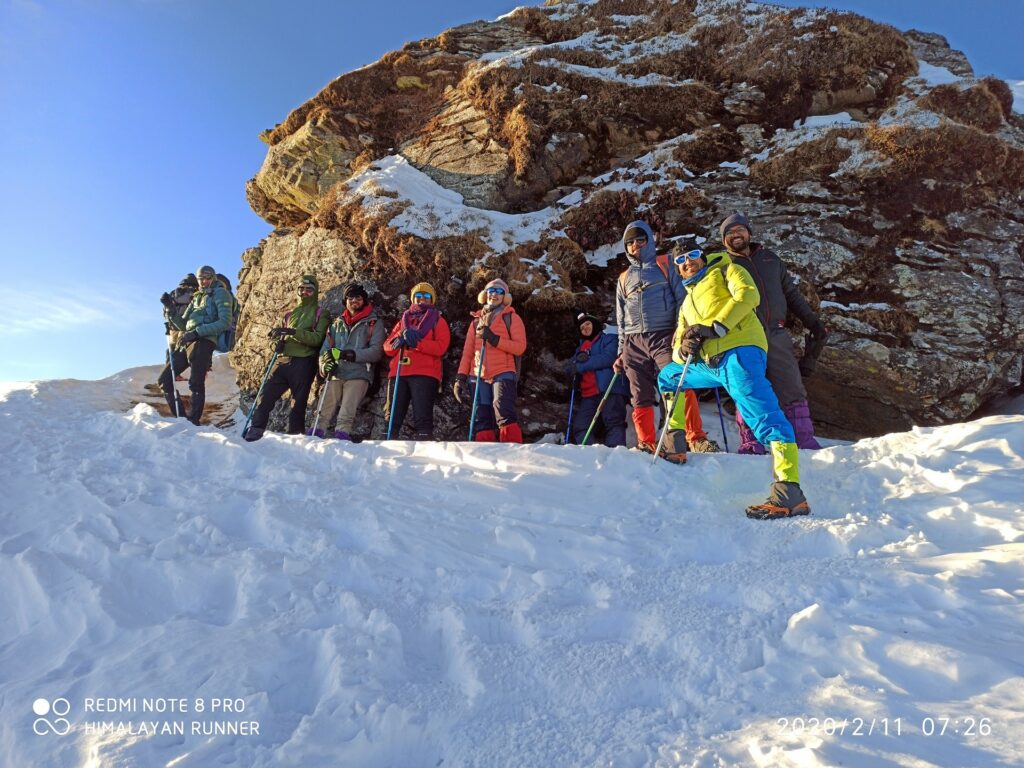
Day 3: Trek from Juda ka Taal to Kedarkantha Base Camp
The Kedarkantha Base Camp is our destination for today’s hiking adventure. We’ll be trekking through some thick pine trees as well as some open pastures. The ascent gets off to a brisk start at the Juda Ka Taal campground, but after that, it eases off and becomes a more moderate climb all the way to the Kedarkantha Base Camp. You will be able to obtain a glimpse of the snow-covered Kedarkantha Summit that encompasses 180 degrees from the route. We will be out on the trail for close to three hours. This brief day is specifically designed to give your body the much-needed rest it need before the highly anticipated summit day. This day will also help you naturally acclimatise to the high altitude, so be sure to keep your body hydrated and consume healthy food. Acclimatising to the high altitude will help you more tomorrow, so use today to your advantage. After a quick recap of the previous day’s summit activities, we are going to have an early supper and then turn in for the night. At three in the morning, we will go on the journey to Kedarkantha Peak and begin our ascent.
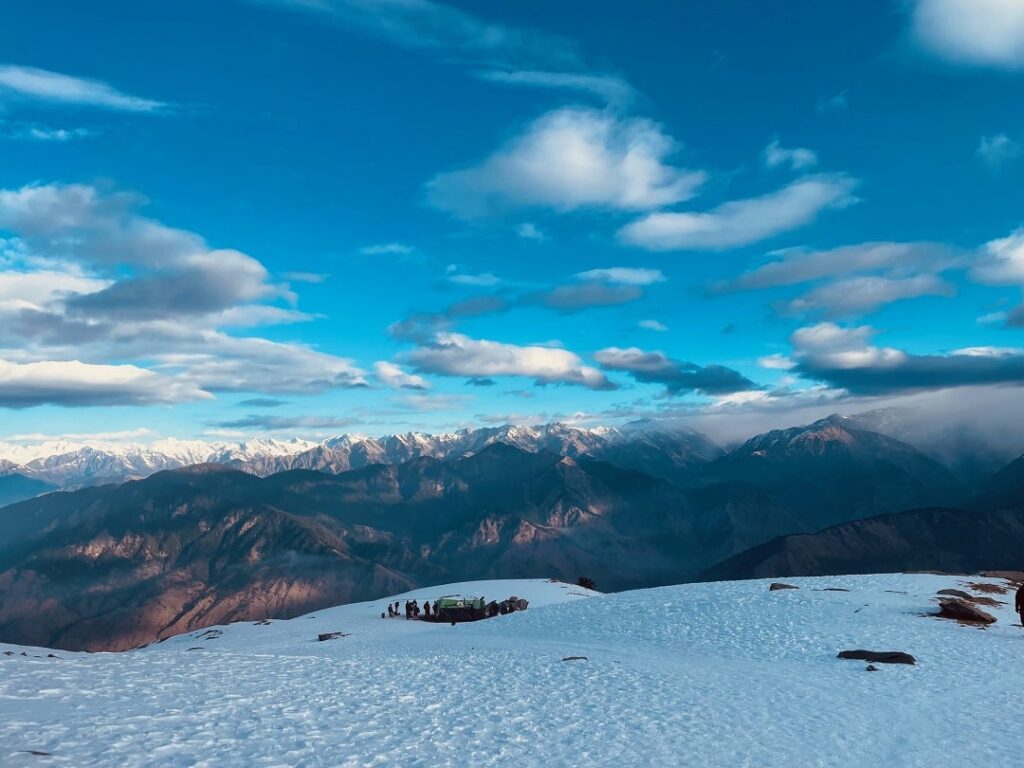
Day 4: Summit attempt and back to Juda Ka Taal
This is going to be the most challenging and exciting day of the walk we are going to be on. Around three in the morning, we will wake up and begin preparing for the trek to the peak of Kedarkantha. We will bring all of the essential gear with us. It is almost certain to be a chilly day, so make sure you are dressed enough to withstand the wind chill on the walk up to the peak. In order to obtain the greatest views of the sun rays striking the snow-capped peaks all around us, we are going to make it our goal to reach the top before dawn. As you make your way to the top of the mountain, you will leave the trees behind you. Both the path and the surroundings are certain to captivate your attention. As we get closer to the top, the vistas will start to open up, which should encourage you to keep going until we reach the top. When you reach the top of the mountain, you will be able to see the whole Himalayan range in every direction. At the very top, there is a shrine dedicated to Lord Shiva. Mountains such as Swargarohini and Bandarpoonch are seen from this vantage point. In addition to these mountain ranges, you may see the Yamunotri ranges and the Gangotri ranges, as well as the Chanshal pass and the Kinner Kailash ranges. After having rested for a while above the mountain, we will make our way back down to the base camp and begin our descent. At the Kedarkantha Base Camp, we’ll have a delicious hot lunch, and then, after taking in the breathtaking views of the mountain, we’ll hike back down to the Juda Ka Taal campground.
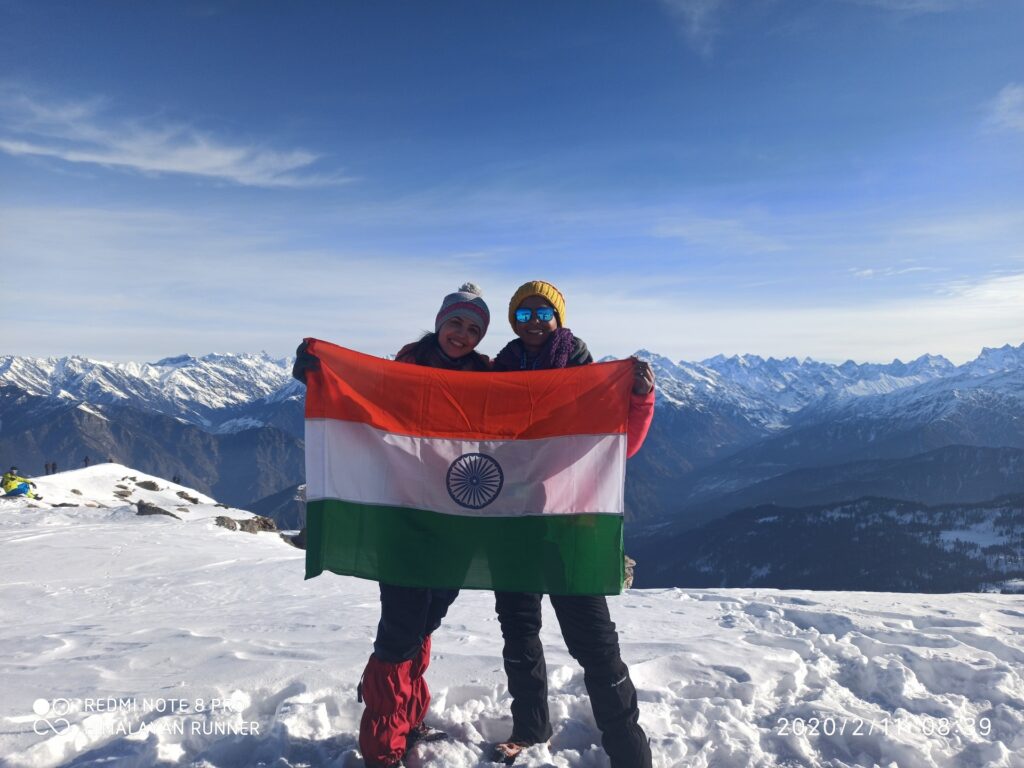
Day 5: Trek from Juda Ka Taal to Sankri and then drive to Dehradun
We are going to have an early breakfast, and then we are going to immediately begin our descent back to the Sankri. During the coldest months of winter, the path may be covered with verglas and might be treacherous. In order to prevent any slips, falls, and injuries, you will need to use extreme caution at all times. When we get to Sankri, your ride back to Dehradun will be waiting for you and it will be ready to go as soon as we get there. You should plan to get in Dehradun about 9 o’clock at night. You will be dropped off at ISBT Dehradun. It is time to say goodbye to your fellow trekkers and go off in our own directions, taking with us a wealth of lovely memories and experiences that will stick with us forever.
FROM WHERE WE CAN RENT TREKKING GEARS DURING KEDARKANTHA TREK?
You can easily rent the gears with minimum price and best in quality:- Gears On Rent



